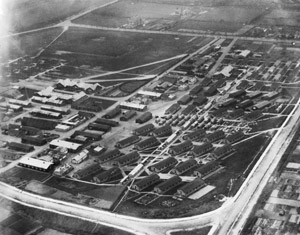Investigating the Home Front 1914-1918

Archaeologists at the University of York are part of a new project to investigate the material remains of the First World War on the British Home Front.
Also involving researchers at the University of Bristol and with the support of £39,500 funding from English Heritage, The Home Front 1914-1918 and its Legacies will serve as a small-scale nine-month pilot for a future national public archaeology project to research and record the remaining traces of the First World War in Britain.
As we approach the 100th anniversary of the First World War, the cultural significance of its surviving legacies comes sharply into view
Dr John Schofield
Dr John Schofield, Head of Archaeology at York, will manage the project along with Dr Nicholas Saunders of Bristol's Department of Archaeology and Anthropology.
The researchers will develop a methodology for use by volunteers to record the physical legacies of the First World War in their localities. Investigations will focus on two test areas – Staffordshire and the Lower Lea Valley, to the north-east of London.
John Schofield, Head of the Archaeology Department says: “As we approach the 100th anniversary of the First World War, the cultural significance of its surviving legacies comes sharply into view. It is also a subject that attracts great public interest. This exciting new project seeks to bring those two strands together: public engagement with documentation of surviving sites and landscapes, to promote awareness, to ensure surviving sites receive appropriate levels of protection, and to facilitate further research.
“With research interests in heritage and historical archaeology, the University of York's Department of Archaeology is well placed to contribute to this important new initiative.”
In Staffordshire, the researchers will work closely with the Historic Environment Record (HER) Services of Staffordshire County Council and the Stoke-on-Trent HER office, while in the Lower Lea Valley they will be collaborating with the Hertfordshire, Essex and Greater London HERs. Local knowledge from these working partnerships will be combined with research undertaken in national archives and museums to construct a comprehensive analysis of the remaining First World War resource.
Wayne Cocroft of English Heritage said: "The common images of the First World War are of fighting men on the Western Front and in the Middle East, mighty battleships, airships, and flimsy aircraft. This exciting project, through the work of volunteers, will for the first time map the more subtle traces of the conflict that are still found in our towns and countryside.
 "It will document memories of how familiar places were drawn into global events: a field used to muster the local volunteer soldiers, a workshop converted to manufacture munitions or a large house used as a hospital. The project offers great potential for people to become involved in exploring the history of their area, and will leave us with a valuable record of the Home Front 1914-1918."
"It will document memories of how familiar places were drawn into global events: a field used to muster the local volunteer soldiers, a workshop converted to manufacture munitions or a large house used as a hospital. The project offers great potential for people to become involved in exploring the history of their area, and will leave us with a valuable record of the Home Front 1914-1918."
The pilot stage will test co-ordination and the use of volunteers through systematic identification, recording and data input of sites. The researchers anticipate locating and recording many different types of sites such as buildings created as a specific response to the First World War in urban and rural environments, bombing or crash sites, requisitioned country estates, military airfields, transport sites, hospitals, wartime graves and cemeteries, street shrines, rolls of honour and places of commemoration and memorialisation.
They will enter this information into a database which will complement and enhance the existing record. On completion of the project, professionals and researchers will be able to gain access to the information through the relevant local Historic Environment Records. The project will then be expanded to a national level between 2014 and 2018 if further funding can be secured.
Further information
- Department of Archaeology
- English Heritage
- Photos: Aerial view of Lydd Military Training Camp in Kent, Feb 1920 (Ref: EPW000066) © English Heritage (Aerofilms Collection) and female workers at the Cunard Shell Works, Bootle, 1917 (Ref: BL24001/037) Reproduced by permission of English Heritage
